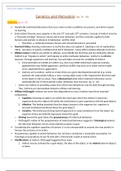Class notes
Genetic Contributions to Motivated Behaviour
- Course
- PSYC2230 (PSYC2230)
- Institution
- York University (Ebor )
Provides information on natural selection, sexual selection, the Parental Investment Model, instinct theory, ethological theory & key concepts, imprinting & critical periods, and human ethology.
[Show more]



